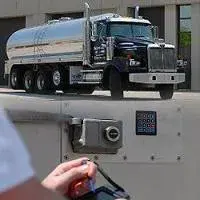 Securing a favorite beverage from farm to fridge
Securing a favorite beverage from farm to fridge
If you’re in the dairy business, moo-ving milk from the cow to the grocery aisle can keep you up late at night. One worry: the shiny aluminum tanker trucks that carry milk between farms and processing plants.
With some 15,000 trucks connecting more than 68,000 dairy farm “dots,” transporting 180 billion pounds of moo juice around the country each year, the potential for spoiled milk begins well before it arrives at your refrigerator shelf.
For the past two years, researchers and engineers from three Kentucky universities have been working on a comprehensive security solution that, as a bonus, happens to improve efficiency by streamlining the way that milk is picked up and delivered.
In October in Lexington, Kentucky, scientists unveiled the Milk Transport and Traceability Security System to an international audience of more than 100 dairy and liquid food transport industry representatives. Department of Homeland Security (DHS) Science and Technology Directorate’s (S&T) Infrastructure and Geophysical Division provided funds for the project through the Kentucky Critical Infrastructure Protection Program.
Following the events of September 2001, including the attack on the World Trade Center and the anthrax scare, milk supply chain security was tightened to prevent chemical or biological attacks. The current security system primarily relies on a series of plastic seals to lock up tanks. Truckers may not know if a seal is broken accidentally while on a highway, or intentionally by a criminal or terrorist, until they arrive at a destination. The result is either a lost load or lost time and resources spent investigating the source of the break.
The new system works by limiting access to the milk and keeping a close eye on every move of the hauler or truck. A key component of the system is a handheld computer, a bit larger than a Blackberry, that haulers use to input information about milk pick-ups, deliveries, and tanker cleanings while traveling their routes. A monitoring system mounted on the truck—comprised of a GPS unit, electronic locks and key pads, and tank temperature sensors—ensures that only authorized milk personnel, like haulers and inspectors, can access the tanker.
As information is entered manually by the hauler or sent automatically by the truck, a separate data server allows supervisors to closely track information from an entire fleet of trucks in near real-time, while cutting down dramatically on paper work and human error, according to Chris Thompson, a University of Kentucky (UK) Regulatory Services milk coordinator.
“This new system is a leap forward in terms of security and efficiency,” said Thompson. “Once implemented, consumers should have even more confidence in the safety of the milk and dairy products they consume every day.”
The new milk security system is a collaboration of the University of Kentucky, Western Kentucky University, and the University of Louisville.
“We must encourage technology solutions that include industry stakeholders, tap into the research and development capabilities at our universities, and keep security costs low for the end-user,” said Kentucky Rep. Hal Rogers, Ranking Member on the House Appropriations Subcommittee for Homeland Security, who attended the demonstration.
Dairy industry representatives are excited about the system’s possibilities, and industry input is being considered as adjustments are made in 2009. Scientists have high hopes that if adopted, the possibility of an udder failure in the milk supply chain can be eliminated.
To request more information about this story, please e-mail st.snapshots@hq.dhs.gov.
